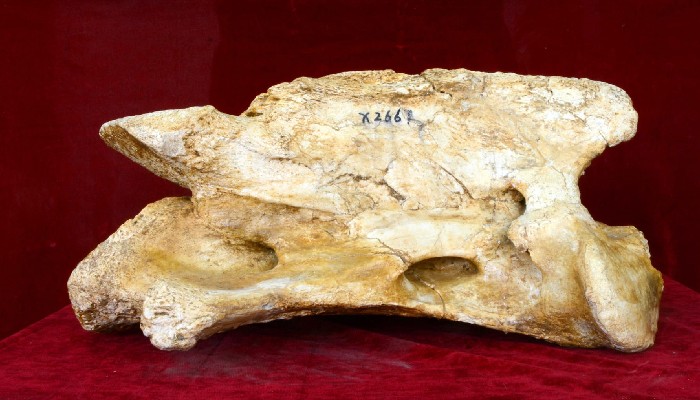Sci-tech
Web Desk
August 03, 2021
The ancient rhino’s skull alone was roughly the size of a human torso while the animal’s shoulders would have reached five meters above the ground

The fossilized skull of the largest land mammal,
Appearing to be some strange mix of a giraffe and an elephant, Paraceratherium was in fact a giant early rhinoceros.
The ancient rhino’s skull alone was roughly the size of a human torso.
Chinese palaeontologists have discovered fossilised remains of the largest land mammal to ever inhabit the Earth.
In a major achievement, Chinese palaeontologists have discovered fossilised remains of the largest land mammal from along the border of the Tibetan plateau.
According to a report published on the World Socialist Web Site (WSWS), a research team from the Institute of Vertebrate Palaeontology and Paleoanthropology (IVPP) of the Chinese Academy of Sciences led by Professor Deng Tao found a new species of Paraceratherium, the largest mammal to ever walk the Earth.
While appearing to be some sort of a strange mix of a giraffe and an elephant, Paraceratherium was in fact a giant early rhinoceros.
The ancient rhino’s skull alone was roughly the size of a human torso while the animal’s shoulders would have reached five meters above the ground. Paraceratherium linxiense is named after the Linxia Basin in central China where its fossils were discovered.
According to the University of Montpellier’s rhino palaeontologist Pierre Olivier, in comments made to National Geographic, Paraceratherium would have been able “to eat flowers at the third or fourth floor of a building” today.
The animal’s very own steps would have been felt through the earth, as estimates suggest it could have weighed a whopping 20 tonnes.
Deng’s team found that early species of Paraceratherium spread to central and south Asia around 43 million years ago.
This giant mammal led an existence similar to a modern giraffe, feeding on huge amounts of plants throughout the Oligocene, a period lasting from 34 to 23 million years ago. It lived in a massive area encompassing what is now modern-day Eurasia.
The findings give palaeontologists clues as to how this rhino genus spread across what is now Eurasia. Paraceratherium likely had social structures and reproductive cycles not dissimilar from the modern elephant, living in small social groups where females would guard younger members of the species.
Ironically it was likely gomphotheres, an ancestor and relative of elephants, that likely drove Paraceratherium to extinction. Like elephants, gomphotheres were mixed browsers, feeding on both grasses and trees.
This change was not restricted to Paraceratherium’s range, as gomphothere descendants spread across the world. The engineering opened new ecological niches and, in turn, enabled animals more closely resembling modern rhinos to diversify and eventually become the horned beasts we know today.
These discoveries have provided numerous fascinating insights into the world of millions of years ago.
Appearing to be some strange mix of a giraffe and an elephant, Paraceratherium was in fact a giant early rhinoceros.
The ancient rhino’s skull alone was roughly the size of a human torso.
Chinese palaeontologists have discovered fossilised remains of the largest land mammal to ever inhabit the Earth.
In a major achievement, Chinese palaeontologists have discovered fossilised remains of the largest land mammal from along the border of the Tibetan plateau.
According to a report published on the World Socialist Web Site (WSWS), a research team from the Institute of Vertebrate Palaeontology and Paleoanthropology (IVPP) of the Chinese Academy of Sciences led by Professor Deng Tao found a new species of Paraceratherium, the largest mammal to ever walk the Earth.
While appearing to be some sort of a strange mix of a giraffe and an elephant, Paraceratherium was in fact a giant early rhinoceros.
The ancient rhino’s skull alone was roughly the size of a human torso while the animal’s shoulders would have reached five meters above the ground. Paraceratherium linxiense is named after the Linxia Basin in central China where its fossils were discovered.
According to the University of Montpellier’s rhino palaeontologist Pierre Olivier, in comments made to National Geographic, Paraceratherium would have been able “to eat flowers at the third or fourth floor of a building” today.
The animal’s very own steps would have been felt through the earth, as estimates suggest it could have weighed a whopping 20 tonnes.
Deng’s team found that early species of Paraceratherium spread to central and south Asia around 43 million years ago.
This giant mammal led an existence similar to a modern giraffe, feeding on huge amounts of plants throughout the Oligocene, a period lasting from 34 to 23 million years ago. It lived in a massive area encompassing what is now modern-day Eurasia.
The findings give palaeontologists clues as to how this rhino genus spread across what is now Eurasia. Paraceratherium likely had social structures and reproductive cycles not dissimilar from the modern elephant, living in small social groups where females would guard younger members of the species.
Ironically it was likely gomphotheres, an ancestor and relative of elephants, that likely drove Paraceratherium to extinction. Like elephants, gomphotheres were mixed browsers, feeding on both grasses and trees.
This change was not restricted to Paraceratherium’s range, as gomphothere descendants spread across the world. The engineering opened new ecological niches and, in turn, enabled animals more closely resembling modern rhinos to diversify and eventually become the horned beasts we know today.
These discoveries have provided numerous fascinating insights into the world of millions of years ago.
No comments:
Post a Comment